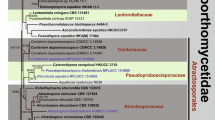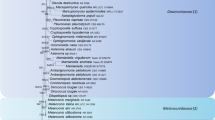Abstract
In this paper we revisit the family Tubeufiaceae with notes on genera that we have re-examined where possible. Generic type specimens of Acanthophiobolus, Kamalomyces, Podonectria, Thaxteriella and Thaxteriellopsis were re-examined, described and illustrated and shown to belong to Tubeufiaceae. Notes are provided on Acanthostigma, Chaetosphaerulina, Thaxterina and Tubeufia, which are retained in Tubeufiaceae; however, we were unable to locate the types of these genera during the time frame of this study. Allonecte is excluded from the Tubeufiaceae, as the ascospores are fusiform-ellipsoidal, grey-brown and 1-septate and the asci are cylindrical, all of which are features more typical of Pleosporaceae, where it is transferred. Byssocallis has yellow to orange ascomata and clavate ascospores which is atypical of Tubeufiaceae. Thus its taxonomic status needs to be reevaluated. Lentendraeopsis has an endophytic habit, cylindro-clavate asci and two-celled ascospores more typical of Pleosporales, where it is transferred. Taphrophila has small ascomata, a thin peridium, branching setae around the apex of the ascomata, clavate to saccate asci and lacks pseudoparaphyses. These are features atypical of the Tubeufiaceae, and Taphrophila should be placed in the Dothideomycetes incertae cedis. Twelve new collections of Tubeufiaceae from Thailand were isolated, and their DNA was extracted. The sequence data of LSU, SSU and ITS rDNA were amplified and analyzed using parsimony and likelihood methods. The results of phylogenetic analysis was used to establish the inter-generic relationships in Tubeufiaceae. Thaxteriellopsis lignicola, epitypified in this investigation, is a sister taxon in the family Tubeufiaceae based on phylogenetic analysis of rRNA sequence data. Chlamydotubeufia is introduced as a new genus based on the production of dictyochlamydosporous anamorphs, including two new species. Three new species, one each in Acanthostigma, Tubeufia and Thaxteriella are also described and illustrated. The phylogenetic placement of these genera is also discussed.



























Similar content being viewed by others
References
Barr ME (1977) Notes on some ‘dimeriaceous’ fungi. Mycotaxon 65:149–171
Barr ME (1979) A classification of Loculoascomycetes. Mycologia 71:935–957
Barr ME (1980) On the family Tubeufiaceae (Pleosporales). Mycotaxon 12:137–167
Berlese AN (1893) Descrizione di alcuni nuovi generi di pirenomiceti. Reprint from Atti del Congresso Botanico Internazionale: 1–10.
Berlese AN (1894) Icones fungorum omnium hucusque cognitorum. Biblioth Mycol 16A:1–243
Bose SK (1961) Studies on Massarina Sacc. and related genera. Phytopathologische Zeitschrift 41:151–213
Cai L, Hyde KD, Tsui CKM (2006) Genera of freshwater fungi. Fungal Diver Res Ser 18:1–261
Cai L, Hyde KD, Taylor PWJ, Weir BS, Waller J, Abang MM, Zhang JZ, Yang YL, Phoulivong S, Liu ZY, Prihastuti H, Shivas RG, McKenzie EHC, Johnston PR (2009) A polyphasic approach for studying Colletotrichum. Fungal Divers 39:183–204
Cannon PF (1997) Two new genera of Ascomycota, and other new or interesting fungi from Slapton Ley National Nature Reserve and its environs. Systema Ascomycetum 15:121–138
Crane JL, Shearer CA, Barr ME (1998) A revision of Boerlagiomyces with notes and a key to the saprobic genera of Tubeufiaceae. Canad J Bot 76:602–612
Hall TA (1999) BioEdit: a user-friendly biological sequence alignment editor and analysis program for Windows 95/98/NT. Nucleic Acids Symposium Series 41:95–98
Hyde KD, Chomnunti P, Crous P, Groenewald J, Damm U, Ko Ko TW, Shivas R, Summerell B, Tan Y (2010) A case for re-inventory of Australia’s plant pathogens. Persoonia 25:50–60
Hyde KD, McKenzie EHC, KoKo TW (2011) Towards incorporating anamorphic fungi in a natural classification–checklist and notes for 2010. Mycosphere 2:1–88
Kirk PM, Cannon PF, David JC, Stalpers JA (2001) Ainsworth & Bisby`s dictionary of the fungi, 9th edn. CABI, Wallingford
Kirk PM, Cannon PF, Minter DW, Stalpers JA (2008) Ainsworth & Bisby`s dictionary of the fungi, 10th edn. CABI, Wallingford
Kodsueb R, Lumyong S, Lumyong P, McKenzie EHC, Ho WH, Hyde KD (2004) Acanthostigma and Tubeufia species, including T. claspisphaeria sp. nov., from submerged wood in Hong Kong. Mycologia 96:667–674
Kodsueb R, Jeewon R, Vijaykrishna D, Mckenzie EHC, Lumyong P, Lumyong S, Hyde KD (2006) Systematic revision of Tubeufiaceae based on morphological and molecular data. Fungal Divers 21:105–130
Ko Ko TW, Stephenson SL, Bahkali AH, Hyde KD (2011) From morphology to molecular biology: can we use sequence data to identify fungal endophytes? Fungal Divers 50:113–120
Larkin MA, Blackshields G, Brown NP, Chenna R, McGettigan PA, McWilliam H, Valentin F, Wallace IM, Wilm A, Lopez R, Thompson JD, Gibson TJ, Higgins DG (2007) Clustal W and Clustal X version 2.0. Bioinformatics 23:2947–2948
Lumbsch HT, Huhndorf SM (eds.) (2010) Outline of Ascomycota – 2009. Myconet 14:1–64
Matsushima T (1975) Icones microfungorum a Matsushima lectorum. Matsushima, Kobe, Japan 209:1–100
Nordén B, Sunhede S, Larsson E (2005) New species of Moristroma (Ascomycetes) and phylogenetic position of the genus. Mycol Prog 4:325–332
Nylander JAA (2004) MrModeltest 2.3. Program distributed by the author. Evolutionary Biology Centre, Uppsala University
Penzig O, Saccardo PA (1904) Icones fungorum javanicorum. E.J. Brill, Leiden
Petch T (1921) Studies in entomogenous fungi. 1. The nectriae parasitic on scale insects. Trans Brit Mycol Soc 7:89–167
Petrak F (1924) Mykologische Notizen VII. Ann Mycol 22:1–182
Petrak F (1951) Ergebnisse einer Revision der Grundtypen verschiedener Gattungen der Askomyzeten und Fungi imperfecti. Sydowia 26:169–198
Petrak F (1953) Ein Beitrag zur Pilzflora Floridas. Sydowia 7:103–132
Promputtha I, Miller AN (2010) Three new species of Acanthostigma (Tubeufiaceae, Dothideomycetes) from Great Smoky Mountains National Park. Mycologia 102:574–587
Rannala B, Yang Z (1996) Probability distribution of molecular evolutionary trees: a new method of phylogenetic inference. J Mole Evol 43:304–311
Réblová M, Barr M (2000) The genus Acanthostigma (Tubeufiaceae, Pleosporales). Sydowia 52:258–285
Rodrigues KF, Samuels GJ (1994) Letendraeopsis palmarum, a new genus and species of loculoascomycetes. Mycologia 86:254–258
Ronquist F, Huelsenbeck JP (2003) MrBayes 3: Bayesian phylogenetic inference under mixed models. Bioinformatics 19:1572
Romero AI, Samuels GJ (1991) Studies on xylophilous fungi from Argentina: VI. Ascomycotina on Eucalyptus viminalis (Myrtaceae). Sydowia 43:228–248
Rossman AY (1977) The genus Ophionectria (Euascomycetes, Hypocreales). Mycologia 69:355–391
Rossman AY (1978) Podonectria, a genus in the Pleosporales on scale insects. Mycotaxon 7:163–182
Rossman AY (1987) The Tubeufiaceae and similar Loculoascomycetes. Mycol Pap 157:1–71
Rossman AY, Samuels GJ, Rogerson CT, Lowen R (1999) Genera of Bionectriaceae, Hypocreaceae and Nectriaceae (Hypocreales, Ascomycetes). Stud Mycol 42:1–248
Samuels GJ, Müller E (1978) Life history studies of Brazilian Ascomycetes 2. Sydowia 31:137–141
Samuels GJ, Rossman AY, Müller E (1979) Life history studies of Brazilian Ascomycetes 6. Three species of Tubeufia with, respectively, dictyosporouspycnidial and helicosporous anamorphs. Sydowia 31:180–192
Sánchez RM, Bianchinotti MV (2010) New records in the Tubeufiaceae from Andean Patagonian forests of Argentina. Mycotaxon 111:131–141
Sánchez RM, Miller AN, Bianchinotti MV (2011) A new species of Acanthostigma (Tubeufiaceae, Dothideomycetes) from the southern hemisphere. Mycologia, doi:10.3852/11-105 (in press)
Scheuer C (1988) Ascomyceten auf Cyperaceen und Juncaceen im Ostalpen-raum. Biblioth Mycol 123:1–124
Scheuer C (1991) Taphrophila (Dothideales: Tubeufiaceae) and two species of Tubeufia with dark setae. Mycol Res 95:811–816
Schoch CL, Crous PW, Groenewald JZ et al (2009) A class-wide phylogenetic assessment of Dothideomycetes. Stud Mycol 64:1–15
Seifert KA, Morgan-Jones G, Gams W, Kendrick B (2011) The Genera of Hyphomycetes. CBS Biodiversity Series 9:1–997
Shearer C (1987) Helicoma chlamydosporum, a new hyphomycete from submerged wood in Panama. Mycologia 79:468–472
Sivanesan A (1984) The Bitunicate Ascomycetes and their Anamorphs Strauss and Cramer Vaduz, Germany
Sivanesan A, Panwar K, Kaur SJ (1976) Thaxteriellopsis lignicola, gen et sp nov, a new Loculoascomycete from India. Kavaka 4:39–42
Sivanesan A, Rajak RC, Gupta RC (1988) Thaxterina, a new tubeufiaceous genus with multispored asci from India. Trans Brit Mycol Soc 90:662–665
Spegazzini CL (1924) Algunos honguitos portoriqueños. Bol Acad Nac Ci 26:335–368
Subramanian C, Sekar G (1982) Thaxteriellopsis lignicola and its Moorella anamorph. Proc Plant Sci 91:1–7
Swofford DL (2002) PAUP*. Phylogenetic Analysis Using Parsimony (* and Others Methods), version 4.0b10 edition. Sinauer Associates, Sunderland, Massachusetts
Sydow H (1939) Fungi Venezuelani. Annales Mycol 28:29–224
Tsui CKM, Berbee ML (2006) Phylogenetic relationships and convergence of helicosporous fungi inferred from ribosomal DNA sequences. Mole Phyl Evol 39:587–597
Tsui CKM, Sivichai S, Berbee ML (2006) Molecular systematics of Helicoma, Helicomyces and Helicosporium and their teleomorphs inferred from rDNA sequences. Mycologia 98:94–104
Tsui CKM, Sivichai S, Rossman AY, Berbee ML (2007) Tubeufia asiana, the teleomorph of Aquaphila albicans in the Tubeufiaceae, Pleosporales, based on cultural and molecular data. Mycologia 99:884–894
Untereiner WA, Straus NA, Malloch D (1995) A molecular-morphotaxonomic approach to the systematics of the Herpotrichiellaceae and allied black yeasts. Mycol Res 99:897–913
Vasilyeva LN, Stephenson SL (2010) The problems of traditional and phylogenetic taxonomy of fungi. Mycosphere 1:45–51
Vilgalys R, Hester M (1990) Rapid genetic identification and mapping of enzymatically amplified ribosomal DNA from several Cryptococcus species. Journal of Bacteriology 172:4238–4246
Walker J (1980) Gaeumannomyces, Linocarpon, Ophiobolus and several other genera of scolecospored ascomycetes and phialophora conidial states, with a note on hyphopodia. Mycotaxon 11:1–129
White T, Bruns T, Lee S, Taylor J (1990) Amplification and direct sequencing of fungal ribosomal RNA genes for phylogenetics. PCR protocols: a guide to methods and applications 18:315–322
Zhang Y, Crous PW, Schoch CL, Hyde KD (2012) Pleosporales. Fungal Divers 52:1–221; doi: 10.1007/s13225-011-0117-x (in press)
Zhao G, Liu X, Wu W (2007) Helicosporous hyphomycetes from China. Fungal Divers 26:313–524
Acknowledgements
The study reported herein was supported by Thailand Research Fund BRG528002. Appreciation is extended to the Global Research Net work for Fungal Biology and King Saud University for their support. The International Fungal Research and Development Centre, The Research Institute of Resource Insects, the Chinese Academy of Forestry (Bailongsi, Kunming 650224, China) and the Key Laboratory of Systematic Mycology and Lichenology, Institute of Microbiology, Chinese Academy of Sciences (Beijing, 100101, China) are also acknowledged for providing laboratory facilities. Thanks go to Cai Lei, Itthayakorn Promputtha, Rampai Kodsueb, Rungtiwa Phookamsak, Jian-Kui Liu and Kritsana Jatuwong for advice and discussions.
Author information
Authors and Affiliations
Corresponding author
Electronic supplementary material
Below is the link to the electronic supplementary material.
Esm 1
(PDF 451 kb)
Rights and permissions
About this article
Cite this article
Boonmee, S., Zhang, Y., Chomnunti, P. et al. Revision of lignicolous Tubeufiaceae based on morphological reexamination and phylogenetic analysis. Fungal Diversity 51, 63–102 (2011). https://doi.org/10.1007/s13225-011-0147-4
Received:
Accepted:
Published:
Issue Date:
DOI: https://doi.org/10.1007/s13225-011-0147-4




